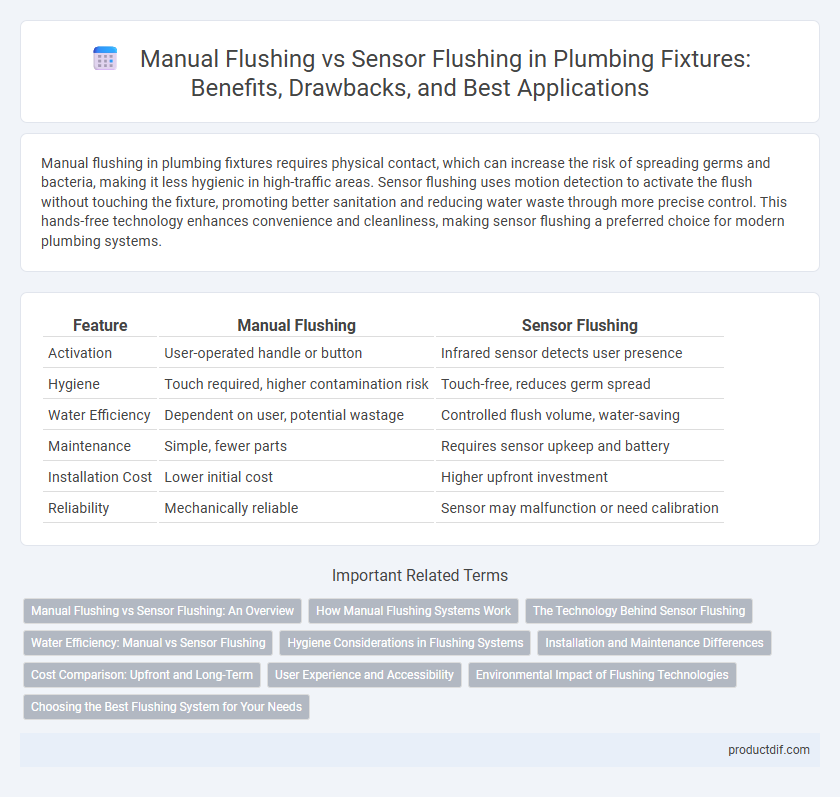Manual flushing in plumbing fixtures requires physical contact, which can increase the risk of spreading germs and bacteria, making it less hygienic in high-traffic areas. Sensor flushing uses motion detection to activate the flush without touching the fixture, promoting better sanitation and reducing water waste through more precise control. This hands-free technology enhances convenience and cleanliness, making sensor flushing a preferred choice for modern plumbing systems.
Table of Comparison
| Feature | Manual Flushing | Sensor Flushing |
|---|---|---|
| Activation | User-operated handle or button | Infrared sensor detects user presence |
| Hygiene | Touch required, higher contamination risk | Touch-free, reduces germ spread |
| Water Efficiency | Dependent on user, potential wastage | Controlled flush volume, water-saving |
| Maintenance | Simple, fewer parts | Requires sensor upkeep and battery |
| Installation Cost | Lower initial cost | Higher upfront investment |
| Reliability | Mechanically reliable | Sensor may malfunction or need calibration |
Manual Flushing vs Sensor Flushing: An Overview
Manual flushing requires physical contact with a lever or button to activate water flow, which can increase the risk of germ transmission in public restrooms. Sensor flushing utilizes infrared or motion sensors to initiate flushing automatically, promoting hygiene and reducing water wastage by precisely controlling flush volume. Installing sensor flush systems improves sanitation standards and offers a hands-free experience compared to traditional manual flushing mechanisms.
How Manual Flushing Systems Work
Manual flushing systems operate through a physical lever or button that users press or pull to release water from the tank into the toilet bowl, initiating the flush cycle. These systems rely on mechanical components such as a flush valve or handle, which directly control the flow of water. Manual flush fixtures are widely used in residential and commercial bathrooms due to their simplicity and reliability without requiring electrical power.
The Technology Behind Sensor Flushing
Sensor flushing technology utilizes infrared or motion sensors to detect user presence, enabling hands-free activation of the flushing mechanism. This system reduces water waste by precisely controlling flush volume and duration based on user interaction, optimizing efficiency compared to manual flushing. Integration with smart plumbing fixtures allows for real-time monitoring and maintenance alerts, enhancing overall operational performance.
Water Efficiency: Manual vs Sensor Flushing
Sensor flushing systems significantly improve water efficiency by delivering precise volumes of water only when needed, reducing waste compared to manual flushing. Manual flush valves often rely on user discretion, which can lead to excessive water use or insufficient flushing. Studies show sensor-operated fixtures can save up to 30% more water in commercial restrooms, making them a sustainable choice in water conservation efforts.
Hygiene Considerations in Flushing Systems
Sensor flushing systems significantly reduce the risk of cross-contamination by eliminating the need for physical contact with handles or buttons, enhancing overall restroom hygiene. Manual flushing relies on touch, which can harbor and transfer bacteria and viruses, increasing the potential for germ spread. Implementing sensor-based flushing contributes to a cleaner environment by minimizing pathogen transmission and promoting effective sanitation in high-traffic areas.
Installation and Maintenance Differences
Manual flushing plumbing fixtures require straightforward installation with basic water supply connections and minimal wiring, simplifying the setup process. Sensor flushing systems involve more complex installation, including electrical wiring, sensor calibration, and potentially battery or power supply integration. Maintenance for manual flush fixtures typically involves fewer components and is less frequent, while sensor flush systems demand regular battery replacement, sensor cleaning, and electronic troubleshooting to ensure consistent performance.
Cost Comparison: Upfront and Long-Term
Manual flushing toilets generally have lower upfront costs, requiring simpler mechanisms and minimal installation expenses, making them budget-friendly initially. Sensor flushing systems involve higher initial investments due to advanced technology and installation complexity but offer significant long-term savings by reducing water usage and maintenance needs. Over time, sensor flushing fixtures can lower operational costs despite the higher upfront expenditure, proving cost-effective in high-traffic or commercial environments.
User Experience and Accessibility
Manual flushing fixtures require physical contact, which can pose hygiene concerns and barriers for users with limited mobility or dexterity. Sensor flushing systems enhance user experience by providing touchless operation, reducing germ transmission and increasing convenience for diverse users, including those with disabilities. These automated fixtures improve accessibility by accommodating individuals who may struggle with manual handles, promoting inclusivity in public and private bathrooms.
Environmental Impact of Flushing Technologies
Manual flushing systems consume more water per use compared to sensor flushing technologies, leading to higher overall water waste in public restrooms. Sensor flushing fixtures use infrared or optical sensors to optimize water flow, reducing unnecessary flushes and conserving potable water resources. The environmental impact of sensor flushing extends to lowering energy consumption for water treatment and decreasing carbon footprints associated with excessive water use.
Choosing the Best Flushing System for Your Needs
Manual flushing fixtures offer simplicity, lower upfront costs, and reliability without requiring power sources, making them ideal for budget-conscious or low-traffic environments. Sensor flushing systems provide hands-free operation, reducing water waste and improving hygiene, which suits high-traffic or public restrooms aiming for sustainability and user convenience. Selecting the best flushing system depends on factors such as maintenance capacity, user volume, installation expenses, and desired water efficiency.
manual flushing vs sensor flushing Infographic

 productdif.com
productdif.com